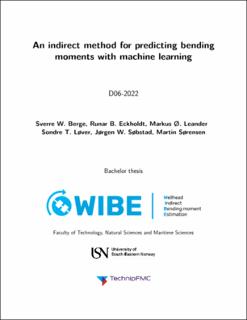An indirect method for predicting bending moments with machine learning : WIBE
Berge, Sverre Weum; Eckholdt, Runar Bergum; Leander, Markus Øvereng; Løver, Sondre Tiller; Søbstad, Jørgen Winther; Sørensen, Martin
Bachelor thesis
Published version
Permanent lenke
https://hdl.handle.net/11250/3030483Utgivelsesdato
2022Metadata
Vis full innførselSamlinger
Sammendrag
In the offshore industry, real-time monitoring of wellhead fatigue is increasingly in demand. The current method of measuring with strain sensors have proven to be expensive and prone to inaccuracies in a complex marine riser system, giving rise to the need for alternative methods. The purpose of this project is to find an indirect method of measuring bending moments acting upon a subsea wellhead, which in turn will be used in fatigue calculations. This will be approached by training a machine learning model to estimate the bending moment with data from motion sensors placed on a marine riser.
Using artificial neural networks this project analyzed data, from both historical operations and simulations in the dynamic analysis software OrcaFlex, to estimate wellhead fatigue. Furthermore, conventional filters such as Kalman filters were created and utilized to preprocess data before the neural networks made predictions. A simplified mathematical model of the system using Lagrangian and Hamiltonian mechanics was partly used as input for the Kalman filter.
This gave rise to a recurrent neural network with a R2 value of 0.95, using only accelerometers and gyroscopes. A convolutional neural network trained on simulated OrcaFlex data gave a R2 value of 0.93, when validated against historical data.
This project proves to a large extent that a machine learning model can be used to predict wellhead fatigue with high accuracy, potentially making strain sensors redundant. Training convolutional neural networks on simulated data should be expanded further and replicated over a longer period of time. Further studies are needed to explore the use of Kalman filters based on Euler-Lagrange equations in artificial neural networks.
Beskrivelse
Utført i samarbeid med: TechnipFMC
